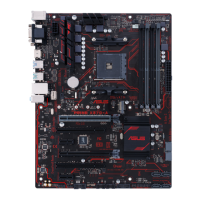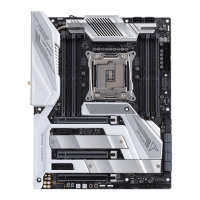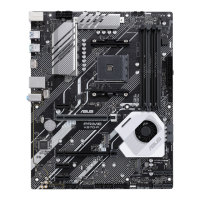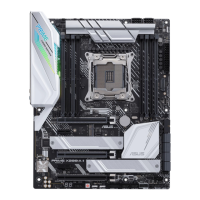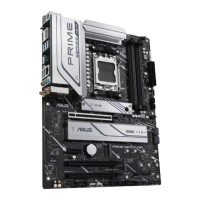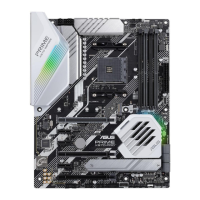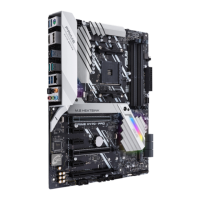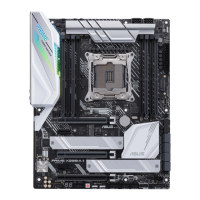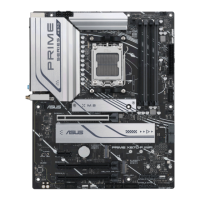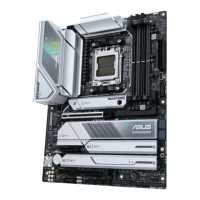Do you have a question about the Asus PRIME X370-PRO and is the answer not in the manual?
Safety guidelines to prevent electrical shock and damage when working with computer components.
Precautions for safe handling, installation, and environmental factors for hardware.
Explains the organization and overall content of the user manual.
References for obtaining further product and software updates.
Explains symbols, warnings, and text formatting used throughout the manual.
Core specifications for CPU socket, chipset, and memory support.
Details on PCIe slots, graphics, and storage interfaces like M.2/SATA.
Connectivity specs (LAN, Audio, USB) and ASUS-specific features.
In-depth look at ASUS SafeSlot, DIGI+ VRM, and overclocking features.
Comprehensive list of I/O ports, internal connectors, BIOS, and OS support.
Lists all items included in the motherboard package for the user.
Identifies essential tools and components not included in the motherboard package.
Crucial safety precautions to follow before installing components or changing settings.
Diagram and identification of key components and connectors on the motherboard.
Detailed listing and page references for motherboard connectors, jumpers, buttons, and slots.
Correct CPU installation and DDR4 DIMM slot usage guidelines.
Best practices for installing DDR4 DIMMs for optimal performance and compatibility.
Information on PCI Express slots, their types, and operating modes.
Table showing IRQ assignments for various components based on CPU type.
Explanation of the Clear RTC RAM jumper and its function for clearing CMOS.
Details on the 4-pin RGB header for connecting LED strips for customization.
Information on connecting SATA hard drives and initial RAID configuration.
Instructions for connecting front panel audio and USB 2.0 modules to the motherboard.
Details on connecting USB 3.0 and USB 3.1 modules for expanded front panel ports.
Guide to connecting CPU, AIO, and chassis fan cables to motherboard headers.
Instructions for connecting the ATX power supply to the motherboard's 24-pin and 8-pin connectors.
Explanation of connectors for power buttons, LEDs, and reset switches for chassis.
Details on connecting Trusted Platform Module and thermal sensors to the motherboard.
Information on installing M.2 SSDs and connecting serial port modules.
Step-by-step guide for installing the motherboard into the PC chassis.
Instructions on using screws to secure the motherboard to the chassis.
Detailed steps for correctly installing the CPU into the AM4 socket.
Guide for installing the CPU heatsink and fan assembly using Type 1 mounting.
Guide for installing the CPU heatsink and fan assembly using Type 2 mounting.
Step-by-step instructions for installing and removing RAM modules.
How to connect ATX power supply and SATA devices to the motherboard.
Guide for connecting Q-Connector, USB 2.0, and front panel audio connectors.
Instructions for installing PCIe x16 and PCIe x1 expansion cards.
Steps for installing an M.2 SSD module onto the motherboard.
Diagram and explanation of rear panel I/O ports and their functions.
Details on connecting audio devices for 2, 4, 6, or 8-channel configurations.
Visual guides for connecting speakers to 2, 4, and 6-channel audio outputs.
Visual guide for connecting speakers to 8-channel audio outputs.
Steps for powering on the system and understanding POST behavior.
Methods for safely shutting down or putting the computer into sleep mode.
Introduction to BIOS, its function, and when to access Setup.
Instructions on how to enter BIOS Setup and general navigation tips.
Introduction to the user-friendly EZ Mode for basic system information and settings.
Explanation of the Advanced Mode for detailed BIOS configuration options.
Overview of the menu bar, items, and key features like Language and Q-Fan Control.
Explains tools like FAQ search, hotkeys, scroll bar, and configuration fields for BIOS.
How to use Q-Fan Control to set fan profiles or manually adjust fan speeds.
Detailed steps for manually configuring fan operating speeds using speed points.
How to save and access frequently used BIOS settings in a personalized menu.
Instructions on adding, deleting, and managing items in the My Favorites BIOS menu.
Overview of the Main menu and how to manage BIOS security settings like passwords.
Guide to configuring overclocking-related settings in the Ai Tweaker menu.
Adjusting CPU core ratio, APU frequency, and other performance-related parameters.
Configuring EPU power saving and TPU automatic overclocking features.
Settings for DRAM timing control, TDP configuration, and DIGI+ VRM.
Fine-tuning DIGI+ VRM settings for CPU and SOC voltage and load-line calibration.
Further DIGI+ VRM adjustments including CPU/SOC switching frequency and power phase control.
Adjusting DRAM, SB, VDDP, and other system voltages for stability and performance.
Introduction to the Advanced menu for CPU and system device configurations.
Details on CPU-related settings like PSS Support, NX Mode, SVM, and IOMMU.
Configuration options for North Bridge and Serial ATA modes (AHCI/RAID).
Settings to enable/disable onboard devices like HD Audio, LAN, USB, and RGB lighting.
Configuration for serial ports, system wake/sleep settings, and UEFI network stack.
Settings for legacy USB support, XHCI hand-off, and individual USB port control.
Displays system temperatures, power status, and allows fan settings adjustment.
How to tune Q-Fan settings and select CPU fan profiles for cooling management.
Configuration for chassis fan speed based on temperature sources and profiles.
Detailed manual settings for AIO pump and chassis fan speeds and temperatures.
Settings for boot speed, logo display, POST delay, and boot device control.
Configuring CSM, boot device priority, and Secure Boot settings.
Managing Secure Boot keys (PK, KEK, DB, DBX) for system security.
Setting boot device priority and overriding boot order for system startup.
Accessing utilities like EZ Flash, Overclocking Profile, and SPD Information.
Saving changes, discarding changes, loading defaults, and launching EFI Shell.
Introduction to utilities for updating the motherboard BIOS.
Step-by-step guide to updating the BIOS using a USB flash drive.
Instructions for updating the BIOS using an internet connection.
How to restore the BIOS using support DVD or USB when corruption occurs.
Explains RAID 0, RAID 1, and RAID 10 configurations and their benefits.
Steps for physically installing SATA hard disks for RAID configuration.
Guide to configuring RAID settings within the UEFI BIOS using RAIDXpert2.
Step-by-step process for creating a RAID set, selecting disks and RAID level.
Setting array size, caching mode, and other policies for the RAID array.
Instructions on how to delete a RAID set and the associated data warning.
Accessing and using the AMD RAID Array configuration utility before OS installation.
Steps for creating a RAID set within the AMD RAID Option ROM utility.
Selecting RAID level and strip size for optimal array performance.
Setting caching mode and confirming the creation of the RAID volume.
Process for deleting a RAID set using the AMD RAID Option ROM utility.
Instructions for creating a RAID driver disk for Windows OS installation.
Regulatory information regarding FCC compliance and potential interference.
Compliance statements for Canada (IC), Japan (VCCI), and Korea (KC).
Information on REACH, recycling, California warnings, and Google license terms.
EU declarations of conformity in various languages as per directives.
Contact details for ASUS technical support worldwide and web resources.
Formal FCC declaration for the PRIME X370-PRO motherboard.
| Non-ECC | Yes |
|---|---|
| Memory channels | Dual-channel |
| Memory slots type | DIMM |
| Number of memory slots | 4 |
| Supported memory types | DDR4-SDRAM |
| Maximum internal memory | 64 GB |
| Supported memory clock speeds | 2133, 2400, 2666, 2933, 3200 MHz |
| Processor socket | Socket AM4 |
| Processor manufacturer | AMD |
| Compatible processor series | AMD A |
| USB 2.0 connectors | 2 |
| Number of SATA II connectors | 0 |
| Number of SATA III connectors | 8 |
| USB 3.2 Gen 1 (3.1 Gen 1) connectors | 1 |
| BIOS type | UEFI AMI |
| ACPI version | 6.1 |
| BIOS memory size | 128 Mbit |
| USB 2.0 ports quantity | USB 2.0 ports have a data transmission speed of 480 Mbps, and are backwards compatible with USB 1.1 ports. You can connect all kinds of peripheral devices to them. |
| USB 3.2 Gen 1 (3.1 Gen 1) Type-A ports quantity | 5 |
| LAN controller | Intel® I211-AT |
| Component for | PC |
| Motherboard chipset | AMD X370 |
| Audio output channels | 7.1 channels |
| Motherboard form factor | ATX |
| Windows operating systems supported | Windows 10 Education, Windows 10 Education x64, Windows 10 Enterprise, Windows 10 Enterprise x64, Windows 10 Home, Windows 10 Home x64, Windows 10 IOT Core, Windows 10 Pro, Windows 10 Pro x64 |
| Depth | 244 mm |
|---|---|
| Width | 305 mm |
